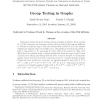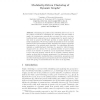226 search results - page 32 / 46 » Lower bounds on the obstacle number of graphs |
JCO
2007
13 years 7 months ago
2007
This paper studies the group testing problem in graphs as follows. Given a graph G = (V, E), determine the minimum number t(G) such that t(G) tests are sufficient to identify an u...
CORR
2011
Springer
13 years 2 months ago
2011
Springer
We consider the task of topology discovery of sparse random graphs using end-to-end random measurements (e.g., delay) between a subset of nodes, referred to as the participants. T...
KR
2004
Springer
14 years 1 months ago
2004
Springer
One of the major advances in classical planning has been the development of Graphplan. Graphplan builds a layered structure called the planning graph, and then searches this struc...
MFCS
2005
Springer
14 years 1 months ago
2005
Springer
Abstract. We introduce nondeterministic graph searching with a controlled amount of nondeterminism and show how this new tool can be used in algorithm design and combinatorial anal...
WEA
2010
Springer
14 years 1 months ago
2010
Springer
Maximizing the quality index modularity has become one of the primary methods for identifying the clustering structure within a graph. As contemporary networks are not static but e...


